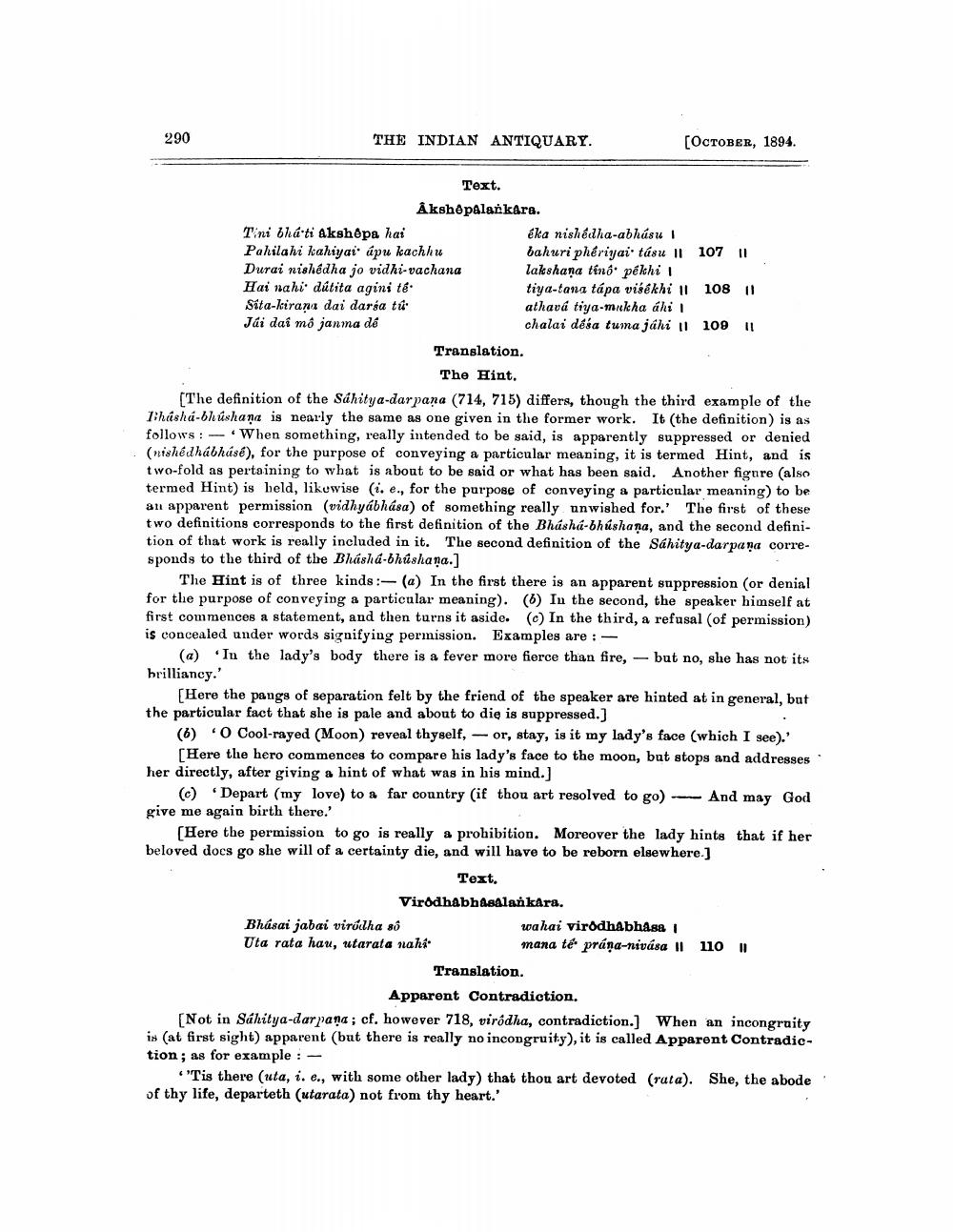________________
290
THE INDIAN ANTIQUARY.
[OCTOBER, 1894.
Text.
Akshepalackara. Tini bháti Akshepa hai
éka nishédha-abhúsu Pahilahi kahiyai' úpu kachhu
bahuri phériyai tásu || 107 11 Durai nishedha jo vidhi-vachana
lakshana tino. pêkhil Hai nahi dútita agini té.
tiya-tang tápa visékhi ll 108 11 Sita-kiranı dai daría tú
athavá tiya-mikha áki Jai daí mó janma de
chalai désa tuma jáhi 11 109 11 Translation.
The Hint. [The definition of the Sahitya-dar pana (714, 715) differs, though the third example of the lihúshá-bhushana is nearly the same as one given in the former work. It (the definition) is as follows:- When something, really intended to be said, is apparently suppressed or denied (nishédhábhúsé), for the purpose of conveying a particular meaning, it is termed Hint, and is two-fold as pertaining to what is about to be said or what has been said. Another figure (also termed Hint) is held, likuwise (i. e., for the purpose of conveying a particular meaning) to be an apparent permission (vidhyábhása) of something really unwished for.' The first of these two definitions corresponds to the first definition of the Bháshá-bhúshana, and the second definition of that work is really included in it. The second definition of the Sahitya-darpana corresponds to the third of the Bhasha-bhúshana.]
The Hint is of three kinds :-(a) In the first there is an apparent suppression (or denial for the purpose of conveying a particular meaning). (6) In the second, the speaker himself at first commences a statement, and then turns it aside. (c) In the third, a refusal (of permission) is concealed under words signifying permission. Examples are: -
(a) In the lady's body there is a fever more fierce than fire, but no, she has not its brilliancy.'
[Here the pange of separation felt by the friend of the speaker are hinted at in general, but the particular fact that she is pale and about to die is suppressed.]
(6) "O Cool-rayed (Moon) reveal thyself, - or, stay, is it my lady's face (which I see).'
[Here the hero commences to compare his lady's face to the moon, but stops and addresses her directly, after giving a hint of what was in his mind.)
(c) Depart (my love) to a far country (if thou art resolved to go) --- And may God give me again birth there.'
[Here the permission to go is really a prohibition. Moreover the lady hints that if her beloved docs go she will of a certainty die, and will have to be reborn elsewhere.)
Text.
Virodhabhasalankara. Bhásai jabai virodha so
wahai virodhAbhasa 1 Uta rata hau, utarata nahi
mana té prána-nivása 11 110 II Translation.
Apparent contradiction. Not in Sahitya-darpana; cf, however 718, virodha, contradiction.] When an incongruity is (at first sight) apparent (but there is really no incongruity), it is called Apparent Contradiction; as for example :
"Tis there (uta, i. e., with some other lady) that thou art devoted (rata). She, the abode of thy life, departeth (utarata) not from thy heart.'




